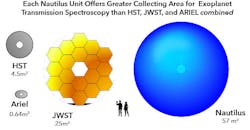Multi-order diffractive optical elements could lead to extremely light space telescopes
Researchers from the University of Arizona (UA; Tucson, AZ) and Northrop Grumman Aerospace Systems (Redondo Beach, CA) are developing a new approach to very large lightweight telescope mirrors that could greatly increase the power of space telescopes while reducing their fabrication and launch costs.1 The concept is based on multi-order diffractive optical elements (MODE lenses) that are ten times lighter per area and 100 times less sensitive to misalignments that conventional lightweight large telescope mirrors.
"We are developing a new technology to replace mirrors in space telescopes," said UA associate professor Daniel Apai, of the UA's Steward Observatory and the Lunar and Planetary Laboratory. "If we succeed, we will be able to vastly increase the light-collecting power of telescopes, and among other science, study the atmospheres of 1000 potentially earthlike planets for signs of life."
Apai leads the space science half of the team, while UA professor Tom Milster, of the James C. Wyant College of Optical Sciences, leads the optical design of a replicable space telescope dubbed Nautilus. The researchers intend to deploy a fleet of 35 14-m-wide spherical telescopes, each individually more powerful than the Hubble Space Telescope, and, combined, having an aperture area equivalent to a 50 m diameter aperture.
Each unit will contain an 8.5-m-diameter MODE lens, which will be used for astronomical observations. One use particularly exciting for Apai is the spectroscopic analysis of starlight as it filters through planetary atmospheres, a technique that could reveal chemical signatures of life.
1000 extrasolar planets within range
When combined, the telescope array will be powerful enough to characterize 1000 extrasolar planets from as far away as 1000 light years. Even NASA's most ambitious space telescope missions are designed to study a handful of potentially Earth-like extrasolar planets.
A MODE lens consists of a multiple-order diffractive element combined with a weak diffractive Fresnel lens, which compensates a small amount of chromatic aberration arising from the multiple-order diffractive element. The MODE lens can be made quickly and cheaply using a molding process.
Because MODE lenses are lighter than mirrors, they are less expensive to launch into space. They are also less sensitive to misalignments, making telescopes built with this technology much more economical. Nautilus telescopes also don't require any fancy observing technique.
"We don't need extremely high-contrast imaging," says Apai. "We don't need a separate spacecraft with a giant starshade to occult the planet host stars. We don't need to go into the infrared. What we do need is to collect lots of light in an efficient and cheap way."
Another advantage: risk would be distributed over many telescopes, so if something goes wrong, the mission isn't scrapped. Many telescopes remain.
In January, Apai and Milster's team, along with UA assistant professor Dae Wook Kim and professor Ronguang Liang of the College of Optical Sciences and Jonathan Arenberg from Northrop Grumman Aerospace Systems, received $1.1 million from the Moore Foundation to create a prototype of a single telescope and test it on the 61-inch Kuiper Telescope on Mt. Bigelow by December 2020.
Sources:
1. https://www.eurekalert.org/pub_releases/2019-08/uoa-anl080219.php
2. http://nautilus-array.space/
REFERENCE
1. Dániel Apai et al., The Astronomical Journal (2019); https://doi.org/10.3847/1538-3881/ab2631.

John Wallace | Senior Technical Editor (1998-2022)
John Wallace was with Laser Focus World for nearly 25 years, retiring in late June 2022. He obtained a bachelor's degree in mechanical engineering and physics at Rutgers University and a master's in optical engineering at the University of Rochester. Before becoming an editor, John worked as an engineer at RCA, Exxon, Eastman Kodak, and GCA Corporation.
